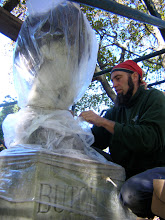Is there a hidden code written into the historic design of Rookwood?
It all happened while I was working on a rather quick and informal submission for the Visual Significance Survey. Its a project of the Rookwood Necropolis Trust– a new committee formed by the Department of Lands to help co-ordinate the various denominational trust (and probably intended to try and amalgamate them if possible) and it is one aspect of their work to formulate a new Plan of Management for Rookwood. (I think they are encouraging public submissions and comments– but they are also under some sort of time restraint & need to show results soon).
I was trying to confirm some observations that one can see from the grounds... namely:
At dawn, the sun rises beside what is now the CBD and illuminates the highrises and the harbour bridge creating an immediate link between the observer and the city. In terms of the historic landscape, this view would have been clearer (without the overgrowth inside the Sections, and without the trees being so large) and the link to the city much more important. Instead of the cemetery seeming to be in the middle of nowhere, many miles outside the built up areas of Sydney in the late 1800s, there would have been a direct visual connection with the community, with the church spires and maybe some early street lights....
So I opened Google Earth to double-check. Oh yes. Very much East... it's obvious and one draws a line and keeps it at 90 degrees. But wait: that's exact. How East? A line drawn at 90.00 degrees from the centre of Necropolis Circuit (the physical and focal heart of the original design for "The Necropolis at Haslem's Creek" passes into downtown AND THROUGH ST JAMES CHURCH. It misses the spire by about 15 metres over the 15 kilometres... ie a 99.99% concordance. Whether serendipity or design, well, it's hard to prove design... but hard to believe in a chance that incredibly slim.
Regardless, however, it IS clear what a connection this makes with Sydney. In the Old Anglican No. 1 Cemetery, the majority of the graves face East. Standing at the foot, or entering the cemetery and walking along the near-East facing avenues, the view to Sydney would be obvious... as it would have been to the surveyors and designers of the Anglican cemetery (who, interestingly, refused to use the initial curvilinear plan of the government designer in order to have linear avenues with central and corner features).
Although now obscured by the mature araucarias (Bunyas, Hoops, Cook Island, & Norfolk Island 'pines') as well as various self-sown trees and overgrown shrubs, when visible, the visual link to Sydney evokes a deep feeling of connectedness. At dawn, especially– like a rising moon seeming so much larger than it does when higher up in the sky– Sydney skyscrapers and the harbour bridge loom large and seem close.
In the 1860s and 70s, when Rookwood Necropolis was first operating, this connection would have been vital: a visual proof that the cemetery was not in the middle of nowhere... despite its real distance from Sydney!
View Rookwood's Da Vinci Code in a larger map
Interestingly, the very word ORIENTATION originates in the idea of facing east. Related to the siting of churches, it was nevertheless the process of designing something such that it faced the ORIENT ie East.
Are there other mystical design elements in Rookwood? I'll let you know if I find any more strange coincidences!
PS: One person who believes that they have found secret patterns in Rookwood is Hu Jin Kok who has studied the Old Chinese area in the General No. 1 Cemetery. It would certainly not be surprising if the design of the area, including the Quong Sin Tong monument is highly purposeful and meaningful given the Chinese cultural traditions of integrating landscape designs into, well, greater landscapes and understandings of cosmic significance. He believes he has found symbols and codes of the Hung Men Society in the tombstones, the Quong Sin Tong monument and the overarching design of the Old Chinese section. See Rookwood Cemetery, Sydney: Chinese Section 1: 1868-1920 for more information... (it's available at the State Reference Library).
If the map is not displaying well, you can try this link: http://maps.google.com/maps/ms?ie=UTF8&hl=en&msa=0&ll=-33.869434,151.131152&spn=0.137829,0.20977&t=h&z=13&msid=114718625818017715056.00048fb3efede90e25b80.
Tuesday, 7 September 2010
Subscribe to:
Post Comments (Atom)



No comments:
Post a Comment